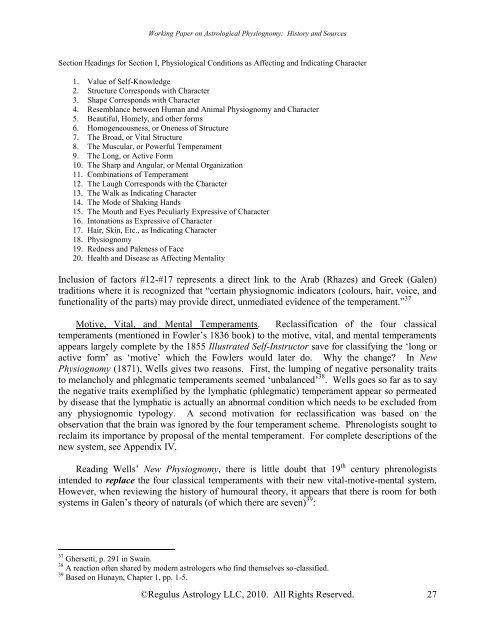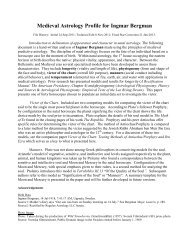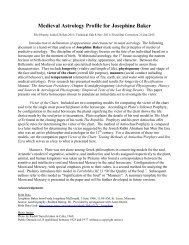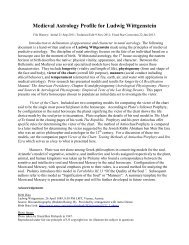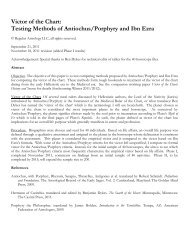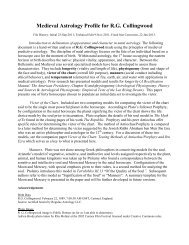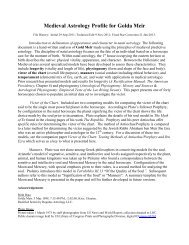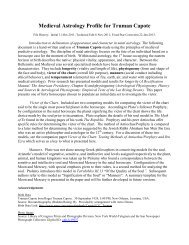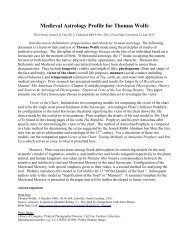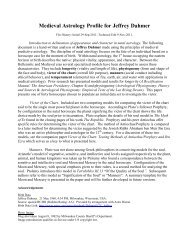Working Paper on Astrological Physiognomy: History and Sources
Working Paper on Astrological Physiognomy: History and Sources
Working Paper on Astrological Physiognomy: History and Sources
You also want an ePaper? Increase the reach of your titles
YUMPU automatically turns print PDFs into web optimized ePapers that Google loves.
<str<strong>on</strong>g>Working</str<strong>on</strong>g> <str<strong>on</strong>g>Paper</str<strong>on</strong>g> <strong>on</strong> <strong>Astrological</strong> <strong>Physiognomy</strong>: <strong>History</strong> <strong>and</strong> <strong>Sources</strong><br />
Secti<strong>on</strong> Headings for Secti<strong>on</strong> I, Physiological C<strong>on</strong>diti<strong>on</strong>s as Affecting <strong>and</strong> Indicating Character<br />
1. Value of Self-Knowledge<br />
2. Structure Corresp<strong>on</strong>ds with Character<br />
3. Shape Corresp<strong>on</strong>ds with Character<br />
4. Resemblance between Human <strong>and</strong> Animal <strong>Physiognomy</strong> <strong>and</strong> Character<br />
5. Beautiful, Homely, <strong>and</strong> other forms<br />
6. Homogeneousness, or Oneness of Structure<br />
7. The Broad, or Vital Structure<br />
8. The Muscular, or Powerful Temperament<br />
9. The L<strong>on</strong>g, or Active Form<br />
10. The Sharp <strong>and</strong> Angular, or Mental Organizati<strong>on</strong><br />
11. Combinati<strong>on</strong>s of Temperament<br />
12. The Laugh Corresp<strong>on</strong>ds with the Character<br />
13. The Walk as Indicating Character<br />
14. The Mode of Shaking H<strong>and</strong>s<br />
15. The Mouth <strong>and</strong> Eyes Peculiarly Expressive of Character<br />
16. Int<strong>on</strong>ati<strong>on</strong>s as Expressive of Character<br />
17. Hair, Skin, Etc., as Indicating Character<br />
18. <strong>Physiognomy</strong><br />
19. Redness <strong>and</strong> Paleness of Face<br />
20. Health <strong>and</strong> Disease as Affecting Mentality<br />
Inclusi<strong>on</strong> of factors #12-#17 represents a direct link to the Arab (Rhazes) <strong>and</strong> Greek (Galen)<br />
traditi<strong>on</strong>s where it is recognized that “certain physiognomic indicators (colours, hair, voice, <strong>and</strong><br />
functi<strong>on</strong>ality of the parts) may provide direct, unmediated evidence of the temperament.” 37<br />
Motive, Vital, <strong>and</strong> Mental Temperaments. Reclassificati<strong>on</strong> of the four classical<br />
temperaments (menti<strong>on</strong>ed in Fowler’s 1836 book) to the motive, vital, <strong>and</strong> mental temperaments<br />
appears largely complete by the 1855 Illustrated Self-Instructor save for classifying the ‘l<strong>on</strong>g or<br />
active form’ as ‘motive’ which the Fowlers would later do. Why the change? In New<br />
<strong>Physiognomy</strong> (1871), Wells gives two reas<strong>on</strong>s. First, the lumping of negative pers<strong>on</strong>ality traits<br />
to melancholy <strong>and</strong> phlegmatic temperaments seemed ‘unbalanced’ 38 . Wells goes so far as to say<br />
the negative traits exemplified by the lymphatic (phlegmatic) temperament appear so permeated<br />
by disease that the lymphatic is actually an abnormal c<strong>on</strong>diti<strong>on</strong> which needs to be excluded from<br />
any physiognomic typology. A sec<strong>on</strong>d motivati<strong>on</strong> for reclassificati<strong>on</strong> was based <strong>on</strong> the<br />
observati<strong>on</strong> that the brain was ignored by the four temperament scheme. Phrenologists sought to<br />
reclaim its importance by proposal of the mental temperament. For complete descripti<strong>on</strong>s of the<br />
new system, see Appendix IV.<br />
Reading Wells’ New <strong>Physiognomy</strong>, there is little doubt that 19 th century phrenologists<br />
intended to replace the four classical temperaments with their new vital-motive-mental system.<br />
However, when reviewing the history of humoural theory, it appears that there is room for both<br />
systems in Galen’s theory of naturals (of which there are seven) 39 :<br />
37 Ghersetti, p. 291 in Swain.<br />
38 A reacti<strong>on</strong> often shared by modern astrologers who find themselves so-classified.<br />
39 Based <strong>on</strong> Hunayn, Chapter 1, pp. 1-5.<br />
©Regulus Astrology LLC, 2010. All Rights Reserved.<br />
27


